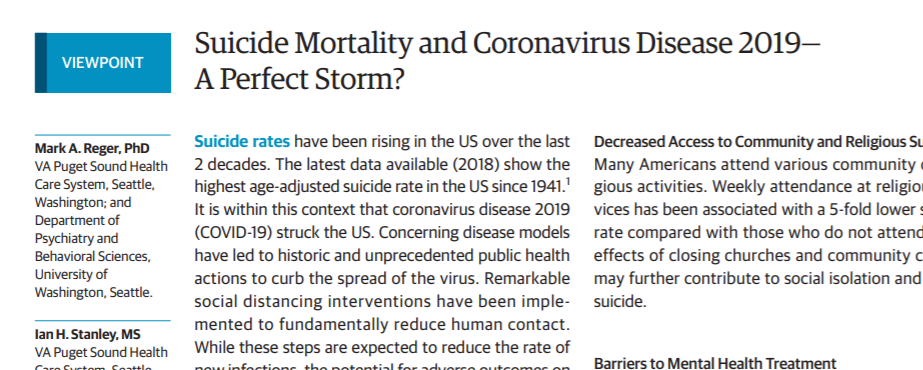
I’ve previously written that healthcare research needs a Journal of Silly Mistakes We Almost Made. Until that journal is established, I’ll have to share my examples with readers of this blog. It’s a small audience, but I like to think it’s a discerning one. Here’s the latest example for that hypothetical journal:
The COVID-19 pandemic has been called the “perfect storm” of increased risk for suicide. Concerns about increasing suicide mortality have even entered the political debate about the negative effects of restrictions on businesses, public gatherings, and in-person schooling. But that discussion has been a largely data-free zone. Official US national statistics on suicide deaths in 2020 will not be released until the fall of 2021.
We hoped that interim mortality data from state departments of health might allow an early look at the effects of the pandemic on suicide mortality. Our first look at Washington state data for January through June of 2020 seemed to indicate a decrease in suicide deaths during April and May. But the number of suicide deaths recorded for June was implausibly low, so we thought we should wait for the next quarterly update before trusting data for April and May.
New state data for deaths recorded through October told a very different story. After including the additional suicide deaths in the new data, the appearance of decreased suicide mortality between April and June almost completely disappeared. And the new data for deaths officially recorded during the fall added significantly to suicide deaths occurring as far back as February and March. So we suspect that suicide death statistics for April, May, and June may still not be complete.
Using the most recent data, we can probably say that there was no dramatic decrease in suicide mortality in Washington during the first three months of the pandemic. But we can’t yet rule out the possibility of a significant increase.
Although the most recent state mortality data added only a few deaths overall during the first quarter of 2020, most of those delayed reports were suicide deaths. It makes sense that suicide deaths would be classified and recorded more slowly than “medically attended” deaths occurring in a hospital. We’re now looking at delays in reporting of suicide deaths across MHRN health systems. It’s possible that the delays we’ve seen are unique to Washington state or unique to the chaos of 2020. We’ll only know that if we look at trends in multiple states, checking carefully for signs that data are not complete. I expect we’ll soon have a clearer picture about the spring and early summer. But we may need to wait a few more months to have accurate data about the fall.
Because we’ve learned from previous mistakes we almost made, we didn’t rush to press with the early news that suicide mortality in Washington state appeared to decrease during the COVID-19 pandemic. Our new message – that we just can’t know the answer yet – will not make any headlines. Others have used early 2020 mortality records to report that overall suicide mortality decreased during the first months of the pandemic. I hope they are right. And I certainly hope they were careful.
Greg Simon

Greg: Good avoidance! The “others’ ” reports of decreased suicide in MA in the earliest months of the Pandemic (and reported in the Wash Post of course) were silly. I tweeted about them even though they came from my medical school. Too much politically correct interpretation, too few deaths and way too few early months of jumpy data for a rare outcome. One can hardly distinguish between the early lockdowns and the ongoing burden of COVID. Congrats for your patience. Best, S
State government in our neck of the woods (Vermont) has exhibited some loss of responsiveness. Budget cuts, personnel access problems, redeployment of personnel from their routine work to COVID-related exigencies all probably play a part in what is recorded and what is reported. I agree that patience is requisite.
Very interesting article about the “Perfect Storm.” You avoided the rush to judgment that frequently occurs when predicting outcomes. The new message that the answer is unknown is a judicious one.